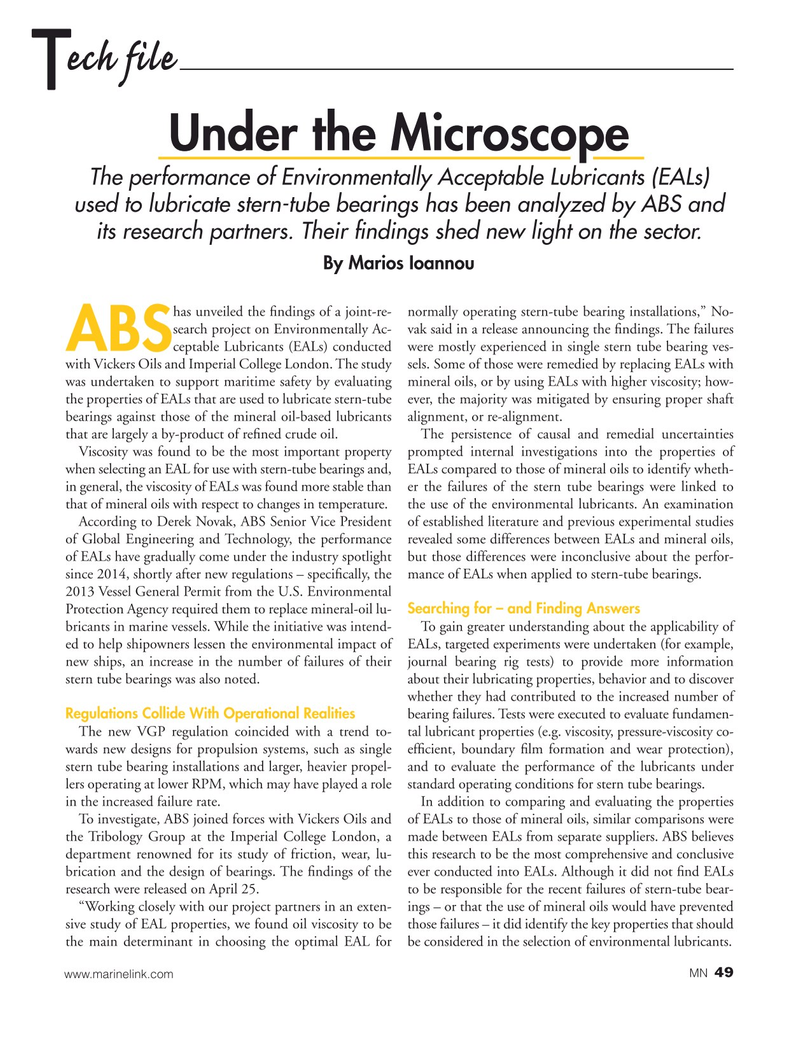
Page 49: of Marine News Magazine (July 2018)
Propulsion Technology
Read this page in Pdf, Flash or Html5 edition of July 2018 Marine News Magazine
ech file
T
Under the Microscope
The performance of Environmentally Acceptable Lubricants (EALs) used to lubricate stern-tube bearings has been analyzed by ABS and its research partners. Their ? ndings shed new light on the sector.
By Marios Ioannou has unveiled the ? ndings of a joint-re- normally operating stern-tube bearing installations,” No- search project on Environmentally Ac- vak said in a release announcing the ? ndings. The failures
ABS ceptable Lubricants (EALs) conducted were mostly experienced in single stern tube bearing ves- with Vickers Oils and Imperial College London. The study sels. Some of those were remedied by replacing EALs with was undertaken to support maritime safety by evaluating mineral oils, or by using EALs with higher viscosity; how- the properties of EALs that are used to lubricate stern-tube ever, the majority was mitigated by ensuring proper shaft bearings against those of the mineral oil-based lubricants alignment, or re-alignment.
that are largely a by-product of re? ned crude oil. The persistence of causal and remedial uncertainties
Viscosity was found to be the most important property prompted internal investigations into the properties of when selecting an EAL for use with stern-tube bearings and, EALs compared to those of mineral oils to identify wheth- in general, the viscosity of EALs was found more stable than er the failures of the stern tube bearings were linked to that of mineral oils with respect to changes in temperature. the use of the environmental lubricants. An examination
According to Derek Novak, ABS Senior Vice President of established literature and previous experimental studies of Global Engineering and Technology, the performance revealed some differences between EALs and mineral oils, of EALs have gradually come under the industry spotlight but those differences were inconclusive about the perfor- since 2014, shortly after new regulations – speci? cally, the mance of EALs when applied to stern-tube bearings.
2013 Vessel General Permit from the U.S. Environmental
Protection Agency required them to replace mineral-oil lu- Searching for – and Finding Answers bricants in marine vessels. While the initiative was intend- To gain greater understanding about the applicability of ed to help shipowners lessen the environmental impact of EALs, targeted experiments were undertaken (for example, new ships, an increase in the number of failures of their journal bearing rig tests) to provide more information stern tube bearings was also noted. about their lubricating properties, behavior and to discover whether they had contributed to the increased number of
Regulations Collide With Operational Realities bearing failures. Tests were executed to evaluate fundamen-
The new VGP regulation coincided with a trend to- tal lubricant properties (e.g. viscosity, pressure-viscosity co- wards new designs for propulsion systems, such as single ef? cient, boundary ? lm formation and wear protection), stern tube bearing installations and larger, heavier propel- and to evaluate the performance of the lubricants under lers operating at lower RPM, which may have played a role standard operating conditions for stern tube bearings.
in the increased failure rate. In addition to comparing and evaluating the properties
To investigate, ABS joined forces with Vickers Oils and of EALs to those of mineral oils, similar comparisons were the Tribology Group at the Imperial College London, a made between EALs from separate suppliers. ABS believes department renowned for its study of friction, wear, lu- this research to be the most comprehensive and conclusive brication and the design of bearings. The ? ndings of the ever conducted into EALs. Although it did not ? nd EALs research were released on April 25. to be responsible for the recent failures of stern-tube bear- “Working closely with our project partners in an exten- ings – or that the use of mineral oils would have prevented sive study of EAL properties, we found oil viscosity to be those failures – it did identify the key properties that should the main determinant in choosing the optimal EAL for be considered in the selection of environmental lubricants. 49 www.marinelink.com MN
MN July18 Layout 32-49.indd 49 MN July18 Layout 32-49.indd 49 6/19/2018 4:08:39 PM6/19/2018 4:08:39 PM

 48
48

 50
50
